Symptoms of Mental Health Disorders in K-12 Systems: A Review
VerifiedAdded on 2022/10/15
|28
|7644
|182
Report
AI Summary
This literature review examines the symptoms of mental health disorders in K-12 students, highlighting their impact on learning and social interactions. It addresses the increasing number of mental health issues, including anxiety, depression, ADHD, and other disorders, and their effects on educational institutions, families, and society. The review explores the causes and prevalence of these disorders, emphasizing the need for preventive measures developed through collaborative efforts of schools, parents, social workers, and mental health professionals. The study discusses the current knowledge on mental illness, its various forms, and the significance of early intervention. It concludes by advocating for interventions and prevention strategies within K-12 systems to support students' mental well-being.
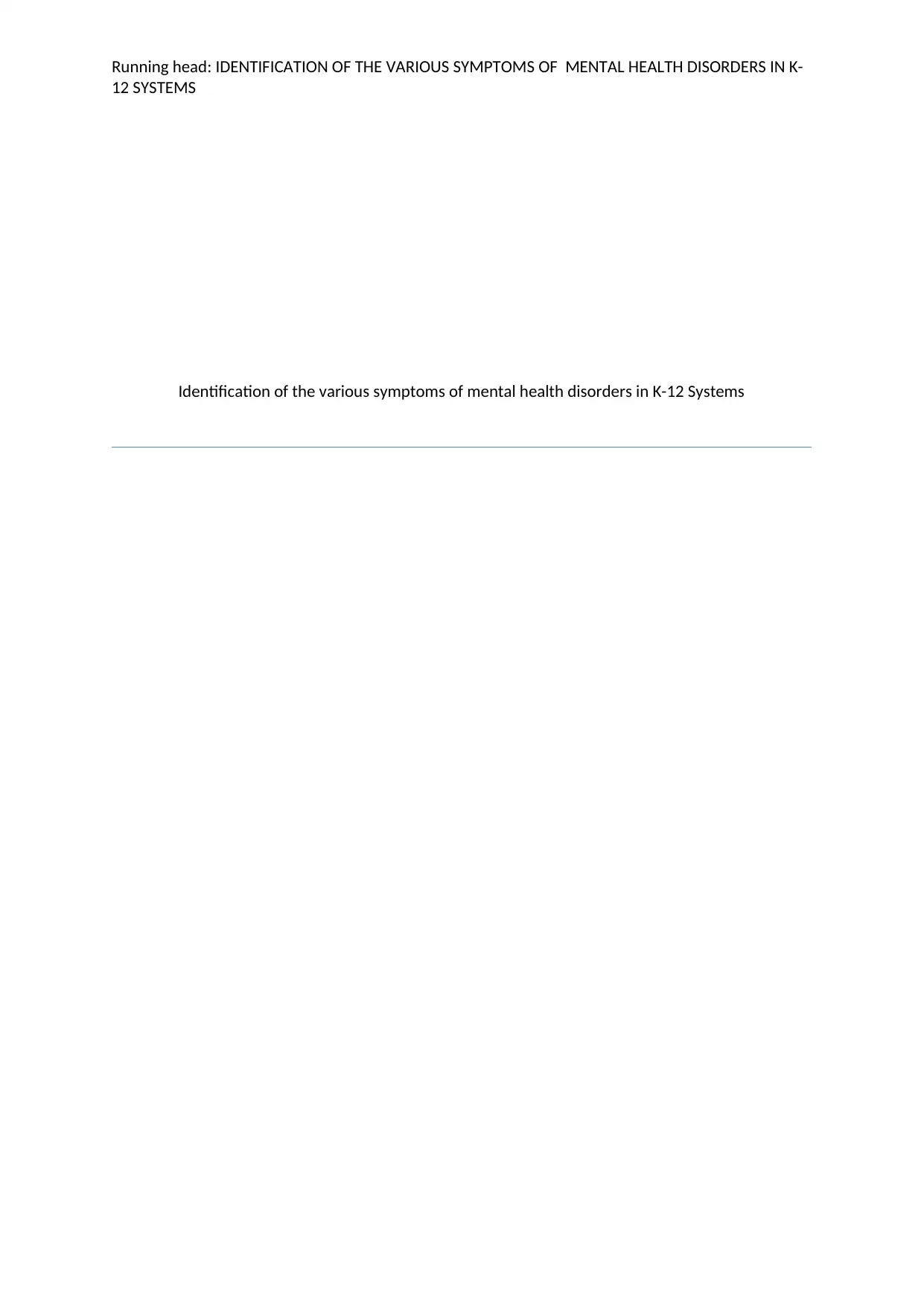
Running head: IDENTIFICATION OF THE VARIOUS SYMPTOMS OF MENTAL HEALTH DISORDERS IN K-
12 SYSTEMS
Identification of the various symptoms of mental health disorders in K-12 Systems
12 SYSTEMS
Identification of the various symptoms of mental health disorders in K-12 Systems
Paraphrase This Document
Need a fresh take? Get an instant paraphrase of this document with our AI Paraphraser
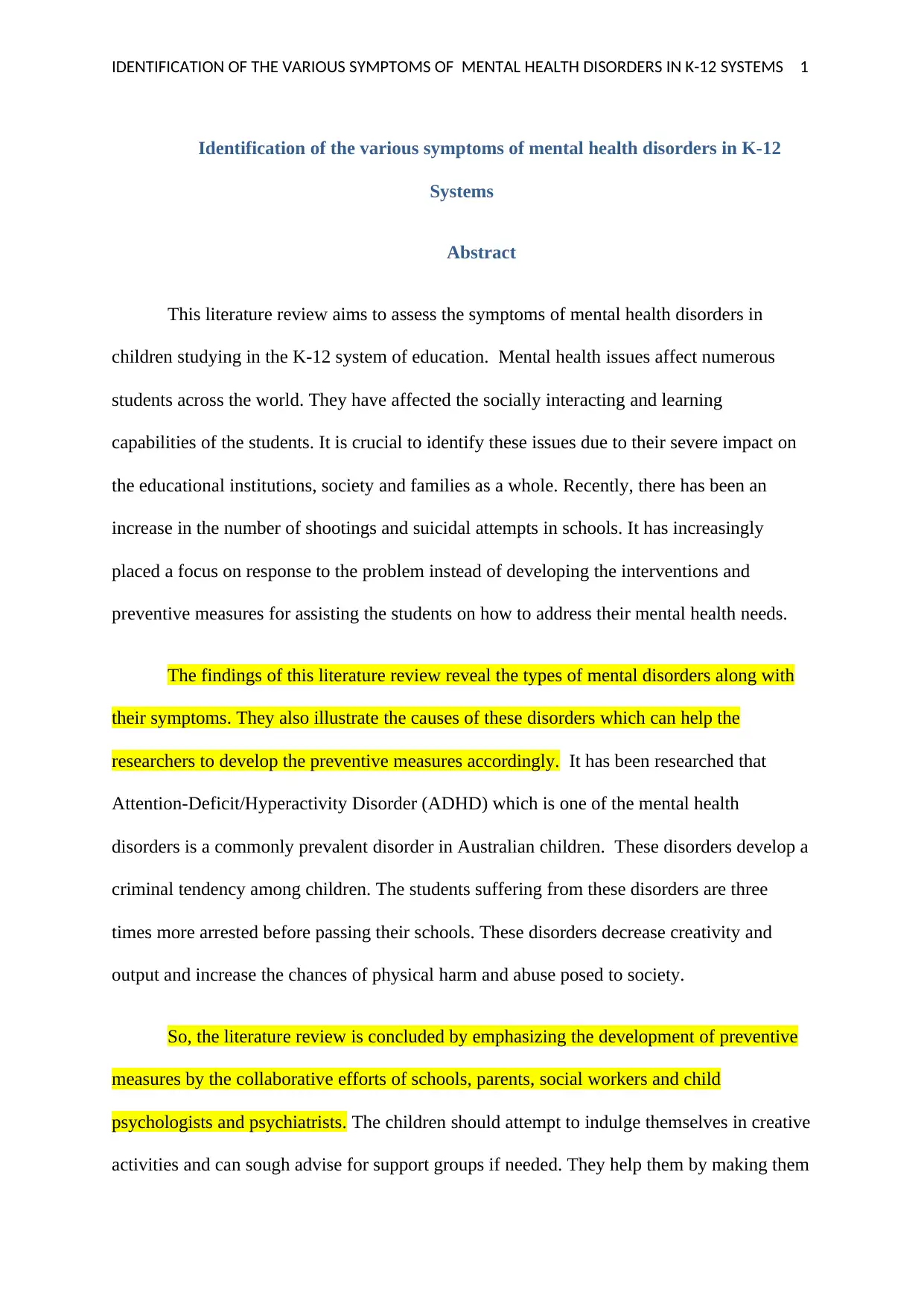
IDENTIFICATION OF THE VARIOUS SYMPTOMS OF MENTAL HEALTH DISORDERS IN K-12 SYSTEMS 1
Identification of the various symptoms of mental health disorders in K-12
Systems
Abstract
This literature review aims to assess the symptoms of mental health disorders in
children studying in the K-12 system of education. Mental health issues affect numerous
students across the world. They have affected the socially interacting and learning
capabilities of the students. It is crucial to identify these issues due to their severe impact on
the educational institutions, society and families as a whole. Recently, there has been an
increase in the number of shootings and suicidal attempts in schools. It has increasingly
placed a focus on response to the problem instead of developing the interventions and
preventive measures for assisting the students on how to address their mental health needs.
The findings of this literature review reveal the types of mental disorders along with
their symptoms. They also illustrate the causes of these disorders which can help the
researchers to develop the preventive measures accordingly. It has been researched that
Attention-Deficit/Hyperactivity Disorder (ADHD) which is one of the mental health
disorders is a commonly prevalent disorder in Australian children. These disorders develop a
criminal tendency among children. The students suffering from these disorders are three
times more arrested before passing their schools. These disorders decrease creativity and
output and increase the chances of physical harm and abuse posed to society.
So, the literature review is concluded by emphasizing the development of preventive
measures by the collaborative efforts of schools, parents, social workers and child
psychologists and psychiatrists. The children should attempt to indulge themselves in creative
activities and can sough advise for support groups if needed. They help them by making them
Identification of the various symptoms of mental health disorders in K-12
Systems
Abstract
This literature review aims to assess the symptoms of mental health disorders in
children studying in the K-12 system of education. Mental health issues affect numerous
students across the world. They have affected the socially interacting and learning
capabilities of the students. It is crucial to identify these issues due to their severe impact on
the educational institutions, society and families as a whole. Recently, there has been an
increase in the number of shootings and suicidal attempts in schools. It has increasingly
placed a focus on response to the problem instead of developing the interventions and
preventive measures for assisting the students on how to address their mental health needs.
The findings of this literature review reveal the types of mental disorders along with
their symptoms. They also illustrate the causes of these disorders which can help the
researchers to develop the preventive measures accordingly. It has been researched that
Attention-Deficit/Hyperactivity Disorder (ADHD) which is one of the mental health
disorders is a commonly prevalent disorder in Australian children. These disorders develop a
criminal tendency among children. The students suffering from these disorders are three
times more arrested before passing their schools. These disorders decrease creativity and
output and increase the chances of physical harm and abuse posed to society.
So, the literature review is concluded by emphasizing the development of preventive
measures by the collaborative efforts of schools, parents, social workers and child
psychologists and psychiatrists. The children should attempt to indulge themselves in creative
activities and can sough advise for support groups if needed. They help them by making them

IDENTIFICATION OF THE VARIOUS SYMPTOMS OF MENTAL HEALTH DISORDERS IN K-12 SYSTEMS 2
interact with children dealing with similar issues. The teachers should assess the stress factors
prevailing in the general environmental settings of the educational institutions and try to
transform these.
interact with children dealing with similar issues. The teachers should assess the stress factors
prevailing in the general environmental settings of the educational institutions and try to
transform these.
⊘ This is a preview!⊘
Do you want full access?
Subscribe today to unlock all pages.

Trusted by 1+ million students worldwide

IDENTIFICATION OF THE VARIOUS SYMPTOMS OF MENTAL HEALTH DISORDERS IN K-12 SYSTEMS 3
Contents
Identification of the various symptoms of mental health disorders in K-12 Systems.............................1
Abstract.................................................................................................................................................1
Background and Context.......................................................................................................................4
Introduction.......................................................................................................................................4
Positionality.......................................................................................................................................4
Methodology.........................................................................................................................................6
Search Terms.........................................................................................................................................6
Inclusion criteria....................................................................................................................................6
Search results....................................................................................................................................7
Discussion and Analysis........................................................................................................................7
The current knowledge about the topic and body of research...........................................................7
What is mental illness?......................................................................................................................7
Significance of new research...............................................................................................................12
Major Depressive Disorder..............................................................................................................13
Autism spectrum disorder................................................................................................................14
Eating Disorders..............................................................................................................................14
Anxiety disorders.............................................................................................................................15
Attention-Deficit/ Hyperactive Disorder..........................................................................................16
Post-Traumatic Stress Disorder.......................................................................................................17
School-based intervention and prevention.......................................................................................18
Research findings............................................................................................................................19
Conclusion...........................................................................................................................................20
References...........................................................................................................................................23
Contents
Identification of the various symptoms of mental health disorders in K-12 Systems.............................1
Abstract.................................................................................................................................................1
Background and Context.......................................................................................................................4
Introduction.......................................................................................................................................4
Positionality.......................................................................................................................................4
Methodology.........................................................................................................................................6
Search Terms.........................................................................................................................................6
Inclusion criteria....................................................................................................................................6
Search results....................................................................................................................................7
Discussion and Analysis........................................................................................................................7
The current knowledge about the topic and body of research...........................................................7
What is mental illness?......................................................................................................................7
Significance of new research...............................................................................................................12
Major Depressive Disorder..............................................................................................................13
Autism spectrum disorder................................................................................................................14
Eating Disorders..............................................................................................................................14
Anxiety disorders.............................................................................................................................15
Attention-Deficit/ Hyperactive Disorder..........................................................................................16
Post-Traumatic Stress Disorder.......................................................................................................17
School-based intervention and prevention.......................................................................................18
Research findings............................................................................................................................19
Conclusion...........................................................................................................................................20
References...........................................................................................................................................23
Paraphrase This Document
Need a fresh take? Get an instant paraphrase of this document with our AI Paraphraser
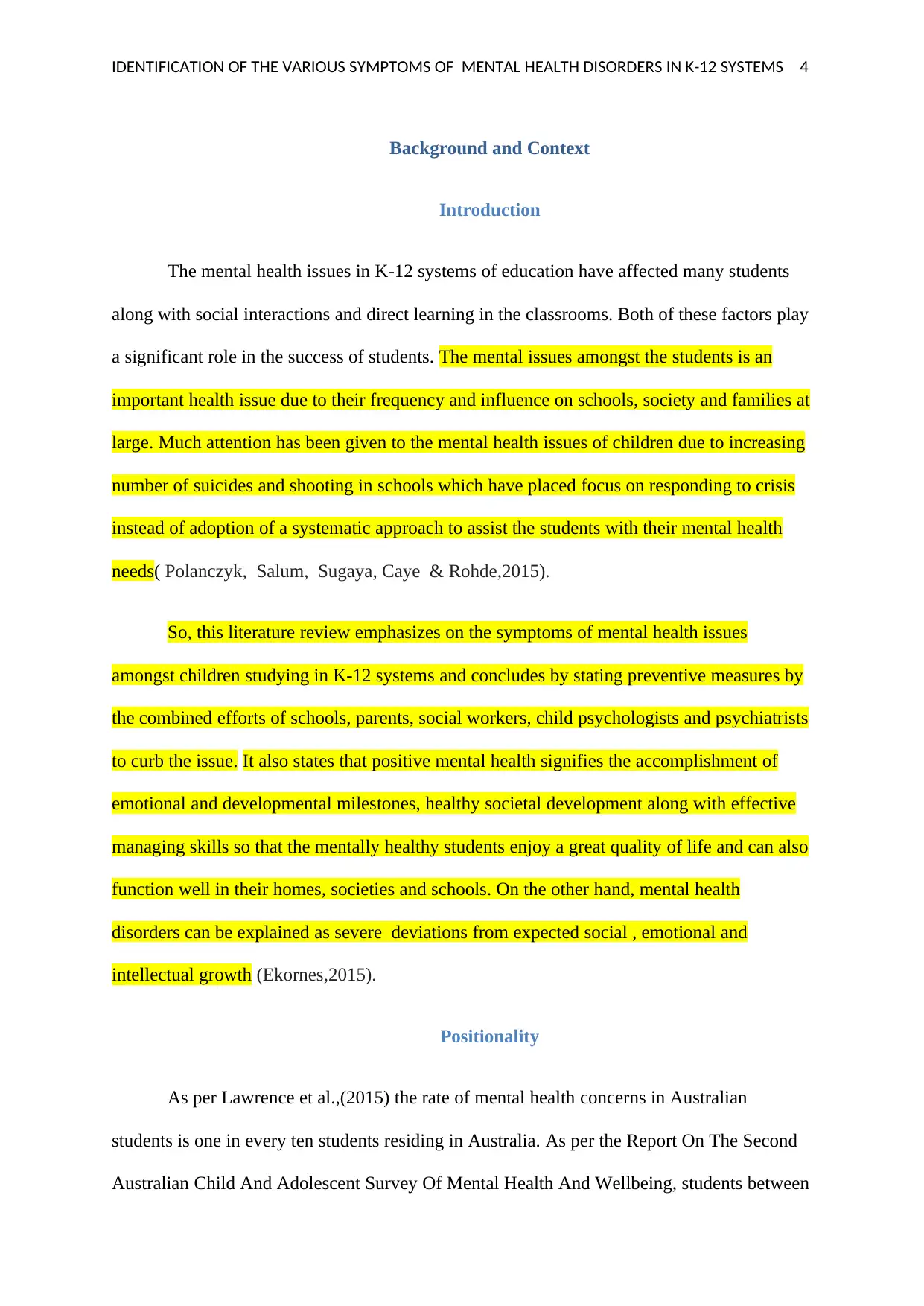
IDENTIFICATION OF THE VARIOUS SYMPTOMS OF MENTAL HEALTH DISORDERS IN K-12 SYSTEMS 4
Background and Context
Introduction
The mental health issues in K-12 systems of education have affected many students
along with social interactions and direct learning in the classrooms. Both of these factors play
a significant role in the success of students. The mental issues amongst the students is an
important health issue due to their frequency and influence on schools, society and families at
large. Much attention has been given to the mental health issues of children due to increasing
number of suicides and shooting in schools which have placed focus on responding to crisis
instead of adoption of a systematic approach to assist the students with their mental health
needs( Polanczyk, Salum, Sugaya, Caye & Rohde,2015).
So, this literature review emphasizes on the symptoms of mental health issues
amongst children studying in K-12 systems and concludes by stating preventive measures by
the combined efforts of schools, parents, social workers, child psychologists and psychiatrists
to curb the issue. It also states that positive mental health signifies the accomplishment of
emotional and developmental milestones, healthy societal development along with effective
managing skills so that the mentally healthy students enjoy a great quality of life and can also
function well in their homes, societies and schools. On the other hand, mental health
disorders can be explained as severe deviations from expected social , emotional and
intellectual growth (Ekornes,2015).
Positionality
As per Lawrence et al.,(2015) the rate of mental health concerns in Australian
students is one in every ten students residing in Australia. As per the Report On The Second
Australian Child And Adolescent Survey Of Mental Health And Wellbeing, students between
Background and Context
Introduction
The mental health issues in K-12 systems of education have affected many students
along with social interactions and direct learning in the classrooms. Both of these factors play
a significant role in the success of students. The mental issues amongst the students is an
important health issue due to their frequency and influence on schools, society and families at
large. Much attention has been given to the mental health issues of children due to increasing
number of suicides and shooting in schools which have placed focus on responding to crisis
instead of adoption of a systematic approach to assist the students with their mental health
needs( Polanczyk, Salum, Sugaya, Caye & Rohde,2015).
So, this literature review emphasizes on the symptoms of mental health issues
amongst children studying in K-12 systems and concludes by stating preventive measures by
the combined efforts of schools, parents, social workers, child psychologists and psychiatrists
to curb the issue. It also states that positive mental health signifies the accomplishment of
emotional and developmental milestones, healthy societal development along with effective
managing skills so that the mentally healthy students enjoy a great quality of life and can also
function well in their homes, societies and schools. On the other hand, mental health
disorders can be explained as severe deviations from expected social , emotional and
intellectual growth (Ekornes,2015).
Positionality
As per Lawrence et al.,(2015) the rate of mental health concerns in Australian
students is one in every ten students residing in Australia. As per the Report On The Second
Australian Child And Adolescent Survey Of Mental Health And Wellbeing, students between
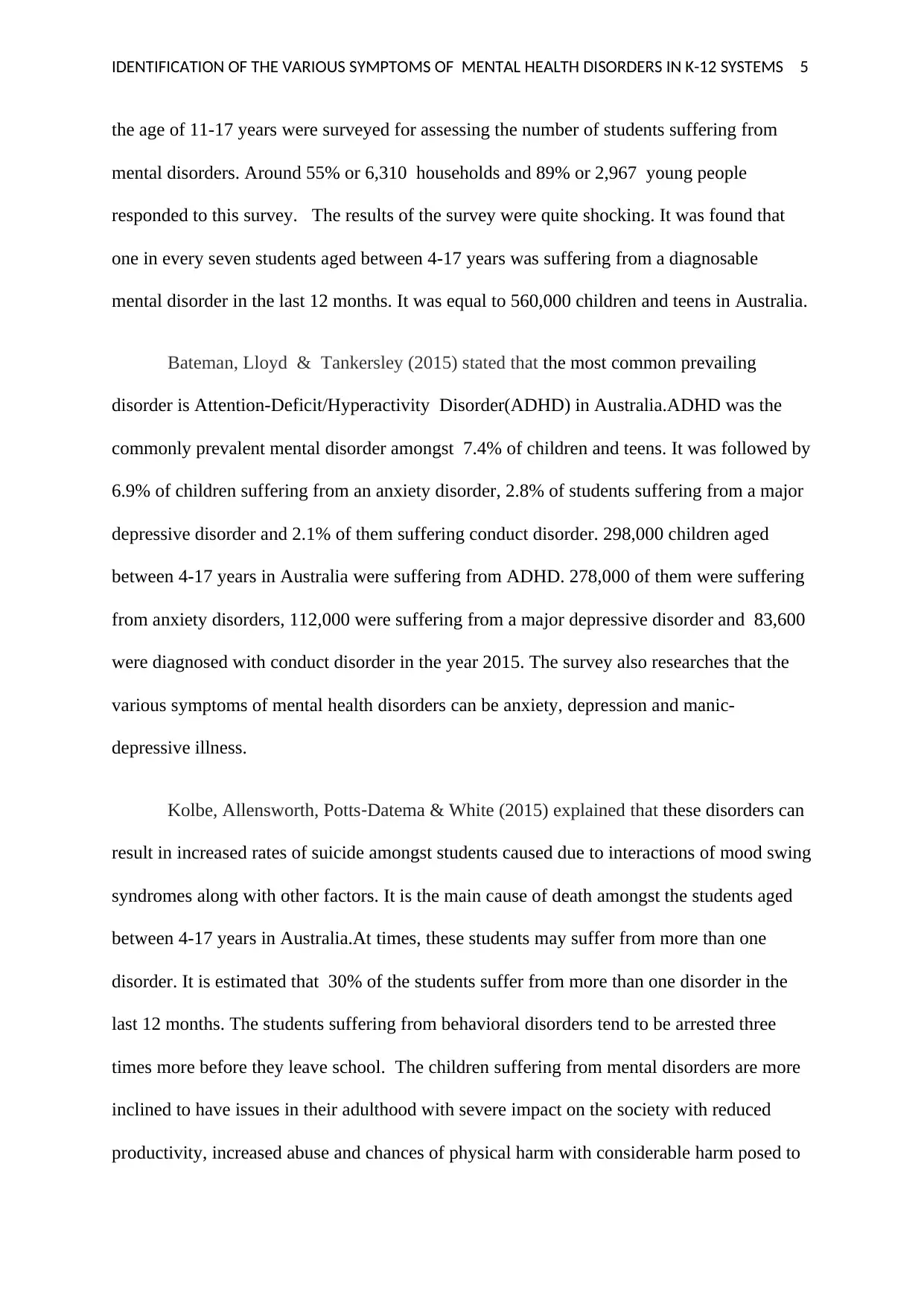
IDENTIFICATION OF THE VARIOUS SYMPTOMS OF MENTAL HEALTH DISORDERS IN K-12 SYSTEMS 5
the age of 11-17 years were surveyed for assessing the number of students suffering from
mental disorders. Around 55% or 6,310 households and 89% or 2,967 young people
responded to this survey. The results of the survey were quite shocking. It was found that
one in every seven students aged between 4-17 years was suffering from a diagnosable
mental disorder in the last 12 months. It was equal to 560,000 children and teens in Australia.
Bateman, Lloyd & Tankersley (2015) stated that the most common prevailing
disorder is Attention-Deficit/Hyperactivity Disorder(ADHD) in Australia.ADHD was the
commonly prevalent mental disorder amongst 7.4% of children and teens. It was followed by
6.9% of children suffering from an anxiety disorder, 2.8% of students suffering from a major
depressive disorder and 2.1% of them suffering conduct disorder. 298,000 children aged
between 4-17 years in Australia were suffering from ADHD. 278,000 of them were suffering
from anxiety disorders, 112,000 were suffering from a major depressive disorder and 83,600
were diagnosed with conduct disorder in the year 2015. The survey also researches that the
various symptoms of mental health disorders can be anxiety, depression and manic-
depressive illness.
Kolbe, Allensworth, Potts‐Datema & White (2015) explained that these disorders can
result in increased rates of suicide amongst students caused due to interactions of mood swing
syndromes along with other factors. It is the main cause of death amongst the students aged
between 4-17 years in Australia.At times, these students may suffer from more than one
disorder. It is estimated that 30% of the students suffer from more than one disorder in the
last 12 months. The students suffering from behavioral disorders tend to be arrested three
times more before they leave school. The children suffering from mental disorders are more
inclined to have issues in their adulthood with severe impact on the society with reduced
productivity, increased abuse and chances of physical harm with considerable harm posed to
the age of 11-17 years were surveyed for assessing the number of students suffering from
mental disorders. Around 55% or 6,310 households and 89% or 2,967 young people
responded to this survey. The results of the survey were quite shocking. It was found that
one in every seven students aged between 4-17 years was suffering from a diagnosable
mental disorder in the last 12 months. It was equal to 560,000 children and teens in Australia.
Bateman, Lloyd & Tankersley (2015) stated that the most common prevailing
disorder is Attention-Deficit/Hyperactivity Disorder(ADHD) in Australia.ADHD was the
commonly prevalent mental disorder amongst 7.4% of children and teens. It was followed by
6.9% of children suffering from an anxiety disorder, 2.8% of students suffering from a major
depressive disorder and 2.1% of them suffering conduct disorder. 298,000 children aged
between 4-17 years in Australia were suffering from ADHD. 278,000 of them were suffering
from anxiety disorders, 112,000 were suffering from a major depressive disorder and 83,600
were diagnosed with conduct disorder in the year 2015. The survey also researches that the
various symptoms of mental health disorders can be anxiety, depression and manic-
depressive illness.
Kolbe, Allensworth, Potts‐Datema & White (2015) explained that these disorders can
result in increased rates of suicide amongst students caused due to interactions of mood swing
syndromes along with other factors. It is the main cause of death amongst the students aged
between 4-17 years in Australia.At times, these students may suffer from more than one
disorder. It is estimated that 30% of the students suffer from more than one disorder in the
last 12 months. The students suffering from behavioral disorders tend to be arrested three
times more before they leave school. The children suffering from mental disorders are more
inclined to have issues in their adulthood with severe impact on the society with reduced
productivity, increased abuse and chances of physical harm with considerable harm posed to
⊘ This is a preview!⊘
Do you want full access?
Subscribe today to unlock all pages.

Trusted by 1+ million students worldwide
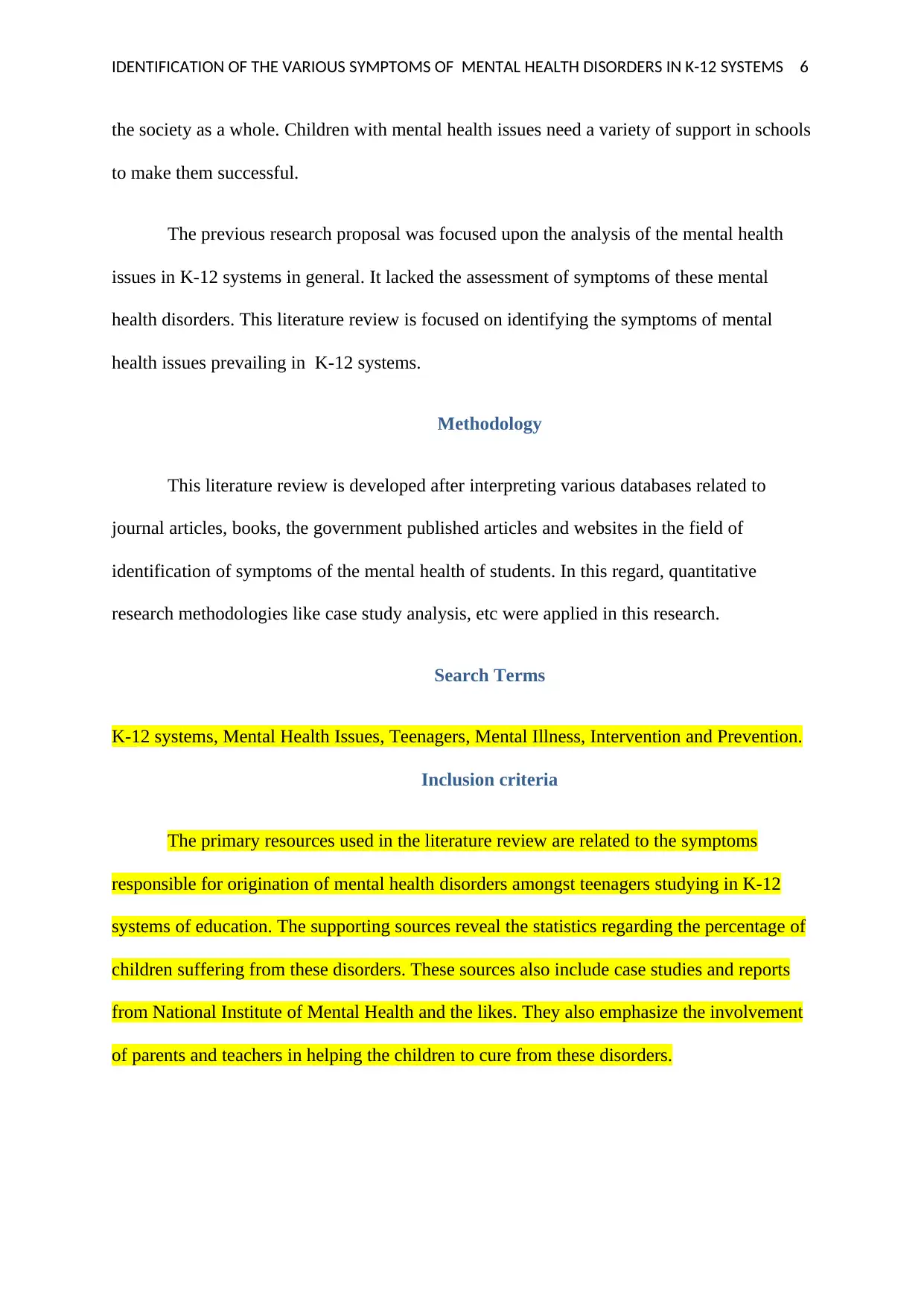
IDENTIFICATION OF THE VARIOUS SYMPTOMS OF MENTAL HEALTH DISORDERS IN K-12 SYSTEMS 6
the society as a whole. Children with mental health issues need a variety of support in schools
to make them successful.
The previous research proposal was focused upon the analysis of the mental health
issues in K-12 systems in general. It lacked the assessment of symptoms of these mental
health disorders. This literature review is focused on identifying the symptoms of mental
health issues prevailing in K-12 systems.
Methodology
This literature review is developed after interpreting various databases related to
journal articles, books, the government published articles and websites in the field of
identification of symptoms of the mental health of students. In this regard, quantitative
research methodologies like case study analysis, etc were applied in this research.
Search Terms
K-12 systems, Mental Health Issues, Teenagers, Mental Illness, Intervention and Prevention.
Inclusion criteria
The primary resources used in the literature review are related to the symptoms
responsible for origination of mental health disorders amongst teenagers studying in K-12
systems of education. The supporting sources reveal the statistics regarding the percentage of
children suffering from these disorders. These sources also include case studies and reports
from National Institute of Mental Health and the likes. They also emphasize the involvement
of parents and teachers in helping the children to cure from these disorders.
the society as a whole. Children with mental health issues need a variety of support in schools
to make them successful.
The previous research proposal was focused upon the analysis of the mental health
issues in K-12 systems in general. It lacked the assessment of symptoms of these mental
health disorders. This literature review is focused on identifying the symptoms of mental
health issues prevailing in K-12 systems.
Methodology
This literature review is developed after interpreting various databases related to
journal articles, books, the government published articles and websites in the field of
identification of symptoms of the mental health of students. In this regard, quantitative
research methodologies like case study analysis, etc were applied in this research.
Search Terms
K-12 systems, Mental Health Issues, Teenagers, Mental Illness, Intervention and Prevention.
Inclusion criteria
The primary resources used in the literature review are related to the symptoms
responsible for origination of mental health disorders amongst teenagers studying in K-12
systems of education. The supporting sources reveal the statistics regarding the percentage of
children suffering from these disorders. These sources also include case studies and reports
from National Institute of Mental Health and the likes. They also emphasize the involvement
of parents and teachers in helping the children to cure from these disorders.
Paraphrase This Document
Need a fresh take? Get an instant paraphrase of this document with our AI Paraphraser
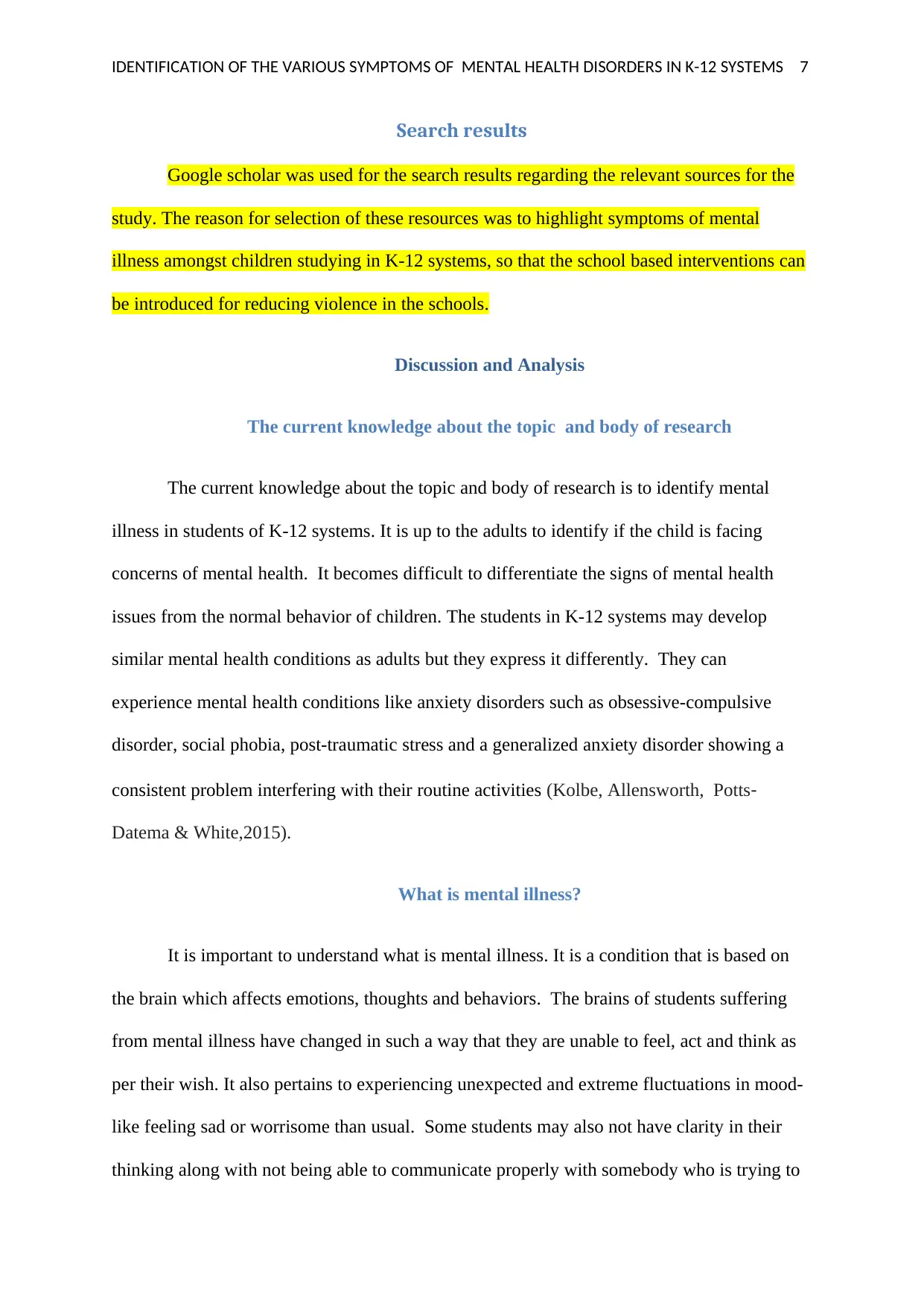
IDENTIFICATION OF THE VARIOUS SYMPTOMS OF MENTAL HEALTH DISORDERS IN K-12 SYSTEMS 7
Search results
Google scholar was used for the search results regarding the relevant sources for the
study. The reason for selection of these resources was to highlight symptoms of mental
illness amongst children studying in K-12 systems, so that the school based interventions can
be introduced for reducing violence in the schools.
Discussion and Analysis
The current knowledge about the topic and body of research
The current knowledge about the topic and body of research is to identify mental
illness in students of K-12 systems. It is up to the adults to identify if the child is facing
concerns of mental health. It becomes difficult to differentiate the signs of mental health
issues from the normal behavior of children. The students in K-12 systems may develop
similar mental health conditions as adults but they express it differently. They can
experience mental health conditions like anxiety disorders such as obsessive-compulsive
disorder, social phobia, post-traumatic stress and a generalized anxiety disorder showing a
consistent problem interfering with their routine activities (Kolbe, Allensworth, Potts‐
Datema & White,2015).
What is mental illness?
It is important to understand what is mental illness. It is a condition that is based on
the brain which affects emotions, thoughts and behaviors. The brains of students suffering
from mental illness have changed in such a way that they are unable to feel, act and think as
per their wish. It also pertains to experiencing unexpected and extreme fluctuations in mood-
like feeling sad or worrisome than usual. Some students may also not have clarity in their
thinking along with not being able to communicate properly with somebody who is trying to
Search results
Google scholar was used for the search results regarding the relevant sources for the
study. The reason for selection of these resources was to highlight symptoms of mental
illness amongst children studying in K-12 systems, so that the school based interventions can
be introduced for reducing violence in the schools.
Discussion and Analysis
The current knowledge about the topic and body of research
The current knowledge about the topic and body of research is to identify mental
illness in students of K-12 systems. It is up to the adults to identify if the child is facing
concerns of mental health. It becomes difficult to differentiate the signs of mental health
issues from the normal behavior of children. The students in K-12 systems may develop
similar mental health conditions as adults but they express it differently. They can
experience mental health conditions like anxiety disorders such as obsessive-compulsive
disorder, social phobia, post-traumatic stress and a generalized anxiety disorder showing a
consistent problem interfering with their routine activities (Kolbe, Allensworth, Potts‐
Datema & White,2015).
What is mental illness?
It is important to understand what is mental illness. It is a condition that is based on
the brain which affects emotions, thoughts and behaviors. The brains of students suffering
from mental illness have changed in such a way that they are unable to feel, act and think as
per their wish. It also pertains to experiencing unexpected and extreme fluctuations in mood-
like feeling sad or worrisome than usual. Some students may also not have clarity in their
thinking along with not being able to communicate properly with somebody who is trying to
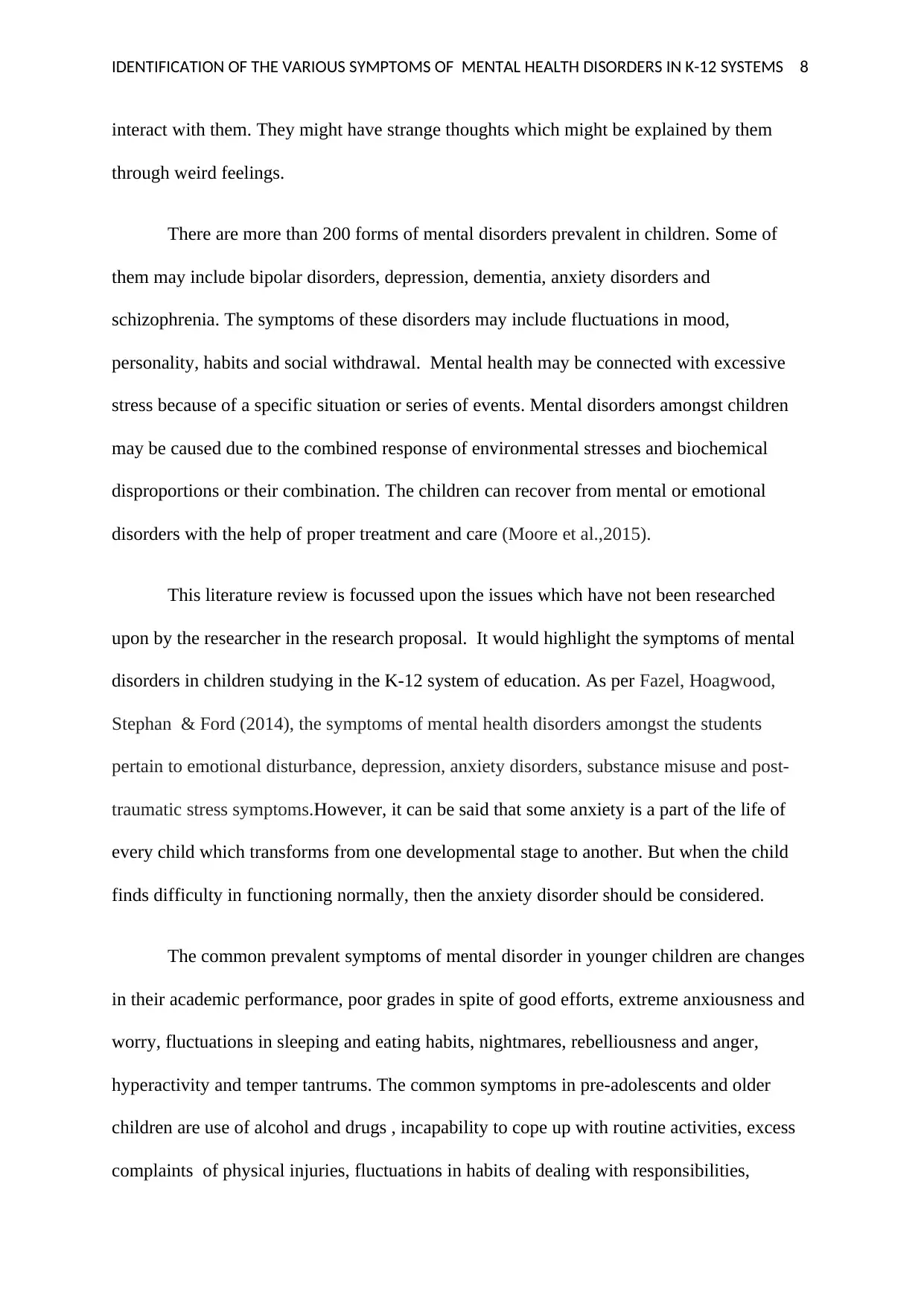
IDENTIFICATION OF THE VARIOUS SYMPTOMS OF MENTAL HEALTH DISORDERS IN K-12 SYSTEMS 8
interact with them. They might have strange thoughts which might be explained by them
through weird feelings.
There are more than 200 forms of mental disorders prevalent in children. Some of
them may include bipolar disorders, depression, dementia, anxiety disorders and
schizophrenia. The symptoms of these disorders may include fluctuations in mood,
personality, habits and social withdrawal. Mental health may be connected with excessive
stress because of a specific situation or series of events. Mental disorders amongst children
may be caused due to the combined response of environmental stresses and biochemical
disproportions or their combination. The children can recover from mental or emotional
disorders with the help of proper treatment and care (Moore et al.,2015).
This literature review is focussed upon the issues which have not been researched
upon by the researcher in the research proposal. It would highlight the symptoms of mental
disorders in children studying in the K-12 system of education. As per Fazel, Hoagwood,
Stephan & Ford (2014), the symptoms of mental health disorders amongst the students
pertain to emotional disturbance, depression, anxiety disorders, substance misuse and post-
traumatic stress symptoms.However, it can be said that some anxiety is a part of the life of
every child which transforms from one developmental stage to another. But when the child
finds difficulty in functioning normally, then the anxiety disorder should be considered.
The common prevalent symptoms of mental disorder in younger children are changes
in their academic performance, poor grades in spite of good efforts, extreme anxiousness and
worry, fluctuations in sleeping and eating habits, nightmares, rebelliousness and anger,
hyperactivity and temper tantrums. The common symptoms in pre-adolescents and older
children are use of alcohol and drugs , incapability to cope up with routine activities, excess
complaints of physical injuries, fluctuations in habits of dealing with responsibilities,
interact with them. They might have strange thoughts which might be explained by them
through weird feelings.
There are more than 200 forms of mental disorders prevalent in children. Some of
them may include bipolar disorders, depression, dementia, anxiety disorders and
schizophrenia. The symptoms of these disorders may include fluctuations in mood,
personality, habits and social withdrawal. Mental health may be connected with excessive
stress because of a specific situation or series of events. Mental disorders amongst children
may be caused due to the combined response of environmental stresses and biochemical
disproportions or their combination. The children can recover from mental or emotional
disorders with the help of proper treatment and care (Moore et al.,2015).
This literature review is focussed upon the issues which have not been researched
upon by the researcher in the research proposal. It would highlight the symptoms of mental
disorders in children studying in the K-12 system of education. As per Fazel, Hoagwood,
Stephan & Ford (2014), the symptoms of mental health disorders amongst the students
pertain to emotional disturbance, depression, anxiety disorders, substance misuse and post-
traumatic stress symptoms.However, it can be said that some anxiety is a part of the life of
every child which transforms from one developmental stage to another. But when the child
finds difficulty in functioning normally, then the anxiety disorder should be considered.
The common prevalent symptoms of mental disorder in younger children are changes
in their academic performance, poor grades in spite of good efforts, extreme anxiousness and
worry, fluctuations in sleeping and eating habits, nightmares, rebelliousness and anger,
hyperactivity and temper tantrums. The common symptoms in pre-adolescents and older
children are use of alcohol and drugs , incapability to cope up with routine activities, excess
complaints of physical injuries, fluctuations in habits of dealing with responsibilities,
⊘ This is a preview!⊘
Do you want full access?
Subscribe today to unlock all pages.

Trusted by 1+ million students worldwide

IDENTIFICATION OF THE VARIOUS SYMPTOMS OF MENTAL HEALTH DISORDERS IN K-12 SYSTEMS 9
intensified fear, frequent anger and persistent negative mood and loss of appetite and
feelings of death( Blodgett & Lanigan, 2018).
As per Association for Children's Mental Health(2019) it is important for the schools
for critically analyze the need for addressing mental health as 1 in every 5 children and youth
are diagnosed with behavioral, emotional and mental health disorders . 1 in every 10 young
people are mentally challenged which is severe to impair their behaviour in school,
community and home. It has been shown by many types of research that children between the
age of 6-17 years are mostly affected by mental disorders. At least 80% of them are not able
to access mental care treatments.
Additionally, mentally disabled students with behavioral and emotional disorders
have the worst rate of graduation amongst all the disabled students. Mental health issues may
affect classroom learning and social interactions which are the crucial factors for the success
of students. Parents often consult the teachers and schools for assessing the role of mental
issues in relationships and the difficulties faced by their children in schools. Some of the
parents misinterpret these symptoms as those about physical ailments but they need to
differentiate between physical and mental disorders. Adeniyi & Omigbodun (2016) argued
that sometimes it is equally challenging for the schools to implement the strategies for
addressing mental health issues and assisting the students to manage their symptoms in a
better way.
Dart et al., (2015) stated that mental health can affect children in numerous ways to
different aspects in the environment of schools. The symptoms of one child may seem to be
difficult to manage whereas another child with the same issues may be easier to handle.
Therefore it is the need of the hour to recognize and support mental health in schools due to
the common prevalence of mental health disorders which often develop during childhood and
intensified fear, frequent anger and persistent negative mood and loss of appetite and
feelings of death( Blodgett & Lanigan, 2018).
As per Association for Children's Mental Health(2019) it is important for the schools
for critically analyze the need for addressing mental health as 1 in every 5 children and youth
are diagnosed with behavioral, emotional and mental health disorders . 1 in every 10 young
people are mentally challenged which is severe to impair their behaviour in school,
community and home. It has been shown by many types of research that children between the
age of 6-17 years are mostly affected by mental disorders. At least 80% of them are not able
to access mental care treatments.
Additionally, mentally disabled students with behavioral and emotional disorders
have the worst rate of graduation amongst all the disabled students. Mental health issues may
affect classroom learning and social interactions which are the crucial factors for the success
of students. Parents often consult the teachers and schools for assessing the role of mental
issues in relationships and the difficulties faced by their children in schools. Some of the
parents misinterpret these symptoms as those about physical ailments but they need to
differentiate between physical and mental disorders. Adeniyi & Omigbodun (2016) argued
that sometimes it is equally challenging for the schools to implement the strategies for
addressing mental health issues and assisting the students to manage their symptoms in a
better way.
Dart et al., (2015) stated that mental health can affect children in numerous ways to
different aspects in the environment of schools. The symptoms of one child may seem to be
difficult to manage whereas another child with the same issues may be easier to handle.
Therefore it is the need of the hour to recognize and support mental health in schools due to
the common prevalence of mental health disorders which often develop during childhood and
Paraphrase This Document
Need a fresh take? Get an instant paraphrase of this document with our AI Paraphraser
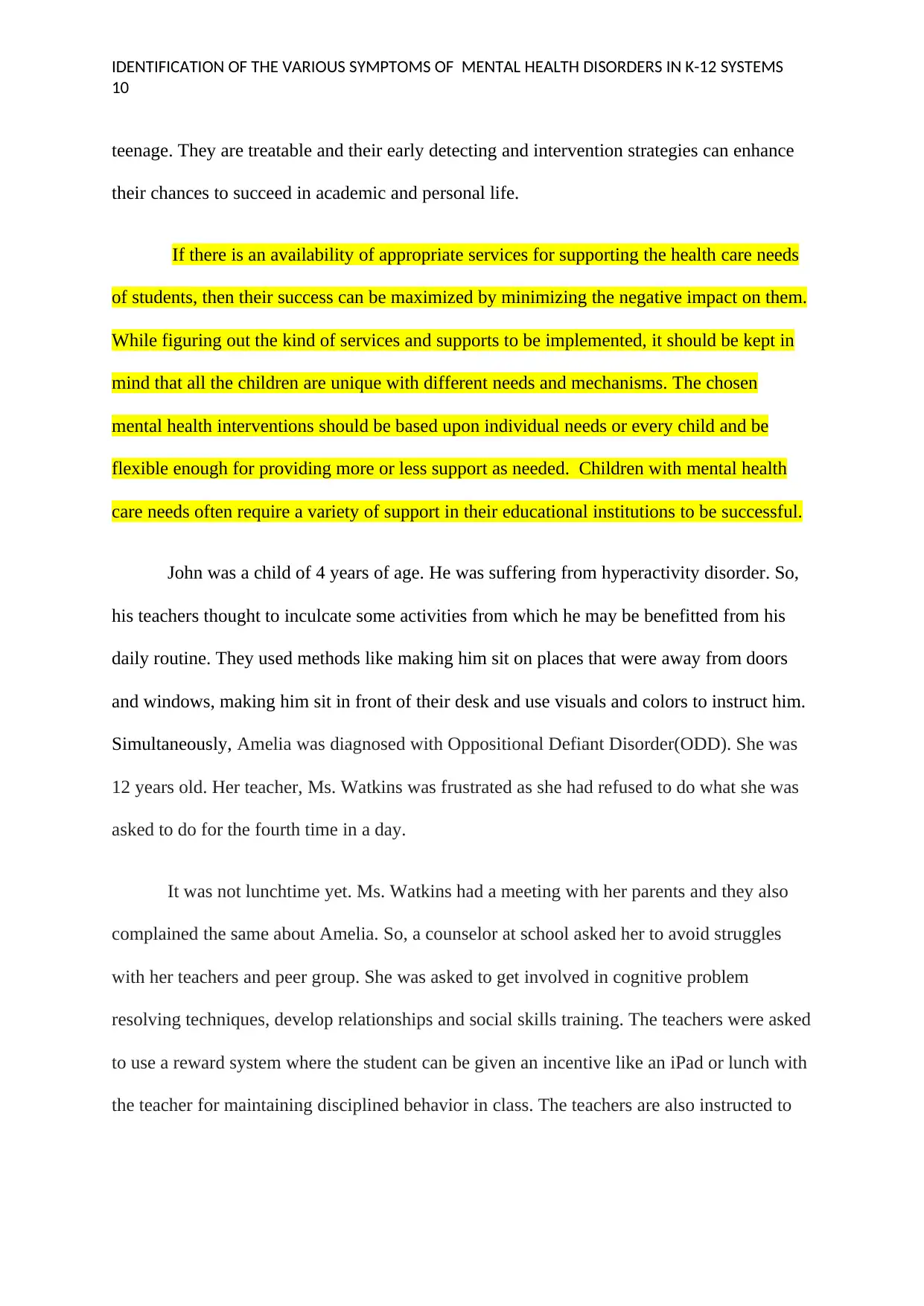
IDENTIFICATION OF THE VARIOUS SYMPTOMS OF MENTAL HEALTH DISORDERS IN K-12 SYSTEMS
10
teenage. They are treatable and their early detecting and intervention strategies can enhance
their chances to succeed in academic and personal life.
If there is an availability of appropriate services for supporting the health care needs
of students, then their success can be maximized by minimizing the negative impact on them.
While figuring out the kind of services and supports to be implemented, it should be kept in
mind that all the children are unique with different needs and mechanisms. The chosen
mental health interventions should be based upon individual needs or every child and be
flexible enough for providing more or less support as needed. Children with mental health
care needs often require a variety of support in their educational institutions to be successful.
John was a child of 4 years of age. He was suffering from hyperactivity disorder. So,
his teachers thought to inculcate some activities from which he may be benefitted from his
daily routine. They used methods like making him sit on places that were away from doors
and windows, making him sit in front of their desk and use visuals and colors to instruct him.
Simultaneously, Amelia was diagnosed with Oppositional Defiant Disorder(ODD). She was
12 years old. Her teacher, Ms. Watkins was frustrated as she had refused to do what she was
asked to do for the fourth time in a day.
It was not lunchtime yet. Ms. Watkins had a meeting with her parents and they also
complained the same about Amelia. So, a counselor at school asked her to avoid struggles
with her teachers and peer group. She was asked to get involved in cognitive problem
resolving techniques, develop relationships and social skills training. The teachers were asked
to use a reward system where the student can be given an incentive like an iPad or lunch with
the teacher for maintaining disciplined behavior in class. The teachers are also instructed to
10
teenage. They are treatable and their early detecting and intervention strategies can enhance
their chances to succeed in academic and personal life.
If there is an availability of appropriate services for supporting the health care needs
of students, then their success can be maximized by minimizing the negative impact on them.
While figuring out the kind of services and supports to be implemented, it should be kept in
mind that all the children are unique with different needs and mechanisms. The chosen
mental health interventions should be based upon individual needs or every child and be
flexible enough for providing more or less support as needed. Children with mental health
care needs often require a variety of support in their educational institutions to be successful.
John was a child of 4 years of age. He was suffering from hyperactivity disorder. So,
his teachers thought to inculcate some activities from which he may be benefitted from his
daily routine. They used methods like making him sit on places that were away from doors
and windows, making him sit in front of their desk and use visuals and colors to instruct him.
Simultaneously, Amelia was diagnosed with Oppositional Defiant Disorder(ODD). She was
12 years old. Her teacher, Ms. Watkins was frustrated as she had refused to do what she was
asked to do for the fourth time in a day.
It was not lunchtime yet. Ms. Watkins had a meeting with her parents and they also
complained the same about Amelia. So, a counselor at school asked her to avoid struggles
with her teachers and peer group. She was asked to get involved in cognitive problem
resolving techniques, develop relationships and social skills training. The teachers were asked
to use a reward system where the student can be given an incentive like an iPad or lunch with
the teacher for maintaining disciplined behavior in class. The teachers are also instructed to
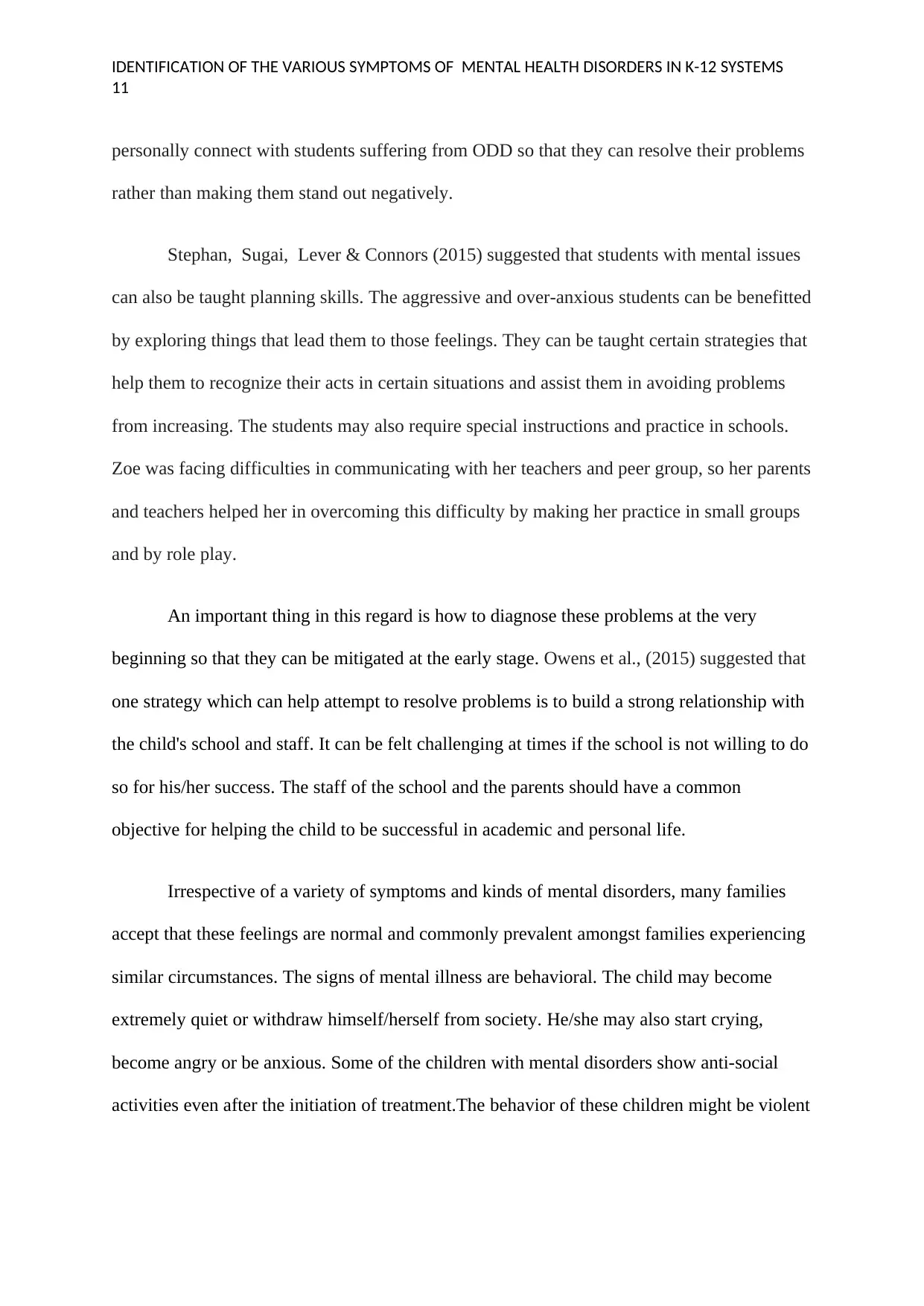
IDENTIFICATION OF THE VARIOUS SYMPTOMS OF MENTAL HEALTH DISORDERS IN K-12 SYSTEMS
11
personally connect with students suffering from ODD so that they can resolve their problems
rather than making them stand out negatively.
Stephan, Sugai, Lever & Connors (2015) suggested that students with mental issues
can also be taught planning skills. The aggressive and over-anxious students can be benefitted
by exploring things that lead them to those feelings. They can be taught certain strategies that
help them to recognize their acts in certain situations and assist them in avoiding problems
from increasing. The students may also require special instructions and practice in schools.
Zoe was facing difficulties in communicating with her teachers and peer group, so her parents
and teachers helped her in overcoming this difficulty by making her practice in small groups
and by role play.
An important thing in this regard is how to diagnose these problems at the very
beginning so that they can be mitigated at the early stage. Owens et al., (2015) suggested that
one strategy which can help attempt to resolve problems is to build a strong relationship with
the child's school and staff. It can be felt challenging at times if the school is not willing to do
so for his/her success. The staff of the school and the parents should have a common
objective for helping the child to be successful in academic and personal life.
Irrespective of a variety of symptoms and kinds of mental disorders, many families
accept that these feelings are normal and commonly prevalent amongst families experiencing
similar circumstances. The signs of mental illness are behavioral. The child may become
extremely quiet or withdraw himself/herself from society. He/she may also start crying,
become angry or be anxious. Some of the children with mental disorders show anti-social
activities even after the initiation of treatment.The behavior of these children might be violent
11
personally connect with students suffering from ODD so that they can resolve their problems
rather than making them stand out negatively.
Stephan, Sugai, Lever & Connors (2015) suggested that students with mental issues
can also be taught planning skills. The aggressive and over-anxious students can be benefitted
by exploring things that lead them to those feelings. They can be taught certain strategies that
help them to recognize their acts in certain situations and assist them in avoiding problems
from increasing. The students may also require special instructions and practice in schools.
Zoe was facing difficulties in communicating with her teachers and peer group, so her parents
and teachers helped her in overcoming this difficulty by making her practice in small groups
and by role play.
An important thing in this regard is how to diagnose these problems at the very
beginning so that they can be mitigated at the early stage. Owens et al., (2015) suggested that
one strategy which can help attempt to resolve problems is to build a strong relationship with
the child's school and staff. It can be felt challenging at times if the school is not willing to do
so for his/her success. The staff of the school and the parents should have a common
objective for helping the child to be successful in academic and personal life.
Irrespective of a variety of symptoms and kinds of mental disorders, many families
accept that these feelings are normal and commonly prevalent amongst families experiencing
similar circumstances. The signs of mental illness are behavioral. The child may become
extremely quiet or withdraw himself/herself from society. He/she may also start crying,
become angry or be anxious. Some of the children with mental disorders show anti-social
activities even after the initiation of treatment.The behavior of these children might be violent
⊘ This is a preview!⊘
Do you want full access?
Subscribe today to unlock all pages.

Trusted by 1+ million students worldwide
1 out of 28
Related Documents
Your All-in-One AI-Powered Toolkit for Academic Success.
+13062052269
info@desklib.com
Available 24*7 on WhatsApp / Email
![[object Object]](/_next/static/media/star-bottom.7253800d.svg)
Unlock your academic potential
Copyright © 2020–2025 A2Z Services. All Rights Reserved. Developed and managed by ZUCOL.





